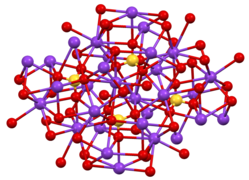पोटेशियम क्रोमेट: Difference between revisions
No edit summary |
No edit summary |
||
| (2 intermediate revisions by 2 users not shown) | |||
| Line 106: | Line 106: | ||
{{Potassium compounds}} | {{Potassium compounds}} | ||
{{Chromates and dichromates}} | {{Chromates and dichromates}} | ||
[[Category:Articles containing unverified chemical infoboxes]] | |||
[[Category:Articles with changed ChemSpider identifier]] | |||
[[Category: | [[Category:Articles with changed EBI identifier]] | ||
[[Category:Articles with changed InChI identifier]] | |||
[[Category:Articles with hatnote templates targeting a nonexistent page]] | |||
[[Category:Articles without KEGG source]] | |||
[[Category:Chembox having GHS data]] | |||
[[Category:Collapse templates]] | |||
[[Category:Created On 18/07/2023]] | [[Category:Created On 18/07/2023]] | ||
[[Category:Lua-based templates]] | |||
[[Category:Machine Translated Page]] | |||
[[Category:Navigational boxes| ]] | |||
[[Category:Navigational boxes without horizontal lists]] | |||
[[Category:Pages using collapsible list with both background and text-align in titlestyle|background:transparent;font-weight:normal;text-align:left ]] | |||
[[Category:Pages with script errors]] | |||
[[Category:Short description with empty Wikidata description]] | |||
[[Category:Sidebars with styles needing conversion]] | |||
[[Category:Template documentation pages|Documentation/doc]] | |||
[[Category:Templates Vigyan Ready]] | |||
[[Category:Templates generating microformats]] | |||
[[Category:Templates that add a tracking category]] | |||
[[Category:Templates that are not mobile friendly]] | |||
[[Category:Templates that generate short descriptions]] | |||
[[Category:Templates using TemplateData]] | |||
[[Category:Wikipedia metatemplates]] | |||
[[Category:ऑक्सीडाइज़िंग एजेंट]] | |||
[[Category:क्रोमेट्स]] | |||
[[Category:पोटेशियम यौगिक]] | |||
Latest revision as of 11:13, 7 August 2023

| |

| |
| Names | |
|---|---|
| IUPAC name
Potassium chromate
| |
| Other names
Chromic acid, (K2CrO4), dipotassium salt
| |
| Identifiers | |
3D model (JSmol)
|
|
| ChEBI | |
| ChemSpider | |
| EC Number |
|
PubChem CID
|
|
| RTECS number |
|
| UNII | |
| |
| |
| Properties | |
| K 2CrO 4 | |
| Molar mass | 194.189 g·mol−1 |
| Appearance | Yellow powder |
| Odor | odorless |
| Density | 2.7320 g/cm3 |
| Melting point | 968 °C (1,774 °F; 1,241 K) |
| Boiling point | 1,000 °C (1,830 °F; 1,270 K) |
| 62.9 g/100 mL (20 °C) 75.1 g/100 mL (80 °C) 79.2 g/100 mL (100 °C) | |
| Solubility | insoluble in alcohol |
| −3.9·10−6 cm3/mol | |
Refractive index (nD)
|
1.74 |
| Structure | |
| rhombic | |
| Hazards | |
| GHS labelling: | |
| H315, H317, H319, H335, H340, H350i, H410 | |
| NFPA 704 (fire diamond) | |
| Safety data sheet (SDS) | Chemical Safety Data |
| Related compounds | |
Other anions
|
Potassium dichromate Potassium molybdate Potassium tungstate |
Other cations
|
Sodium chromate Calcium chromate Barium chromate |
Related chromates
|
Potassium hypochromate Potassium perchromate |
Except where otherwise noted, data are given for materials in their standard state (at 25 °C [77 °F], 100 kPa).
| |
पोटेशियम क्रोमेट K2CrO4 सूत्र वाला एक अकार्बनिक यौगिक है। यह पीला ठोस क्रोमेट आयन का पोटेशियम लवण है। यह एक सामान्य प्रयोगशाला रसायन है, जबकि सोडियम क्रोमेट औद्योगिक रूप से महत्वपूर्ण है।
संरचना
इसके दो क्रिस्टलीय रूप ज्ञात हैं, दोनों ही संबंधित पोटेशियम सल्फेट के समान हैं। विषमलंबाक्ष β-K2CrO4 सामान्य रूप है, परन्तु यह 66 डिग्री सेल्सियस से ऊपर α-रूप में परिवर्तित हो जाता है।[1]ये संरचनाएँ जटिल हैं, यद्यपि क्रोमेट आयन विशिष्ट चतुष्फलकीय ज्यामिति को अपनाता है।[2]
उत्पादन और अभिक्रियाएं
इसे पोटेशियम डाइक्रोमेट को पोटेशियम हाइड्रॉक्साइड के साथ उपचारित करके तैयार किया जाता है:
या, पोटेशियम हाइड्रॉक्साइड और क्रोमियम ट्राइऑक्साइड का संलयन:
विलयन में, पोटेशियम और सोडियम डाइक्रोमेट का व्यवहार बहुत समान होता है। जब लेड (II) नाइट्रेट के साथ इसकी अभिक्रिया करवाई जाती है तो यह एक नारंगी-पीला अवक्षेप, लेड (II) क्रोमेट प्रदान करता है।
अनुप्रयोग
कम महंगे सोडियम लवण के विपरीत, पोटेशियम लवण का उपयोग मुख्य रूप से उन स्थितियों में प्रयोगशाला कार्यों के लिए किया जाता है जहां निर्जल लवण की आवश्यकता होती है।[1] यह कार्बनिक संश्लेषण में ऑक्सीकरण कारक के रूप में है। इसका उपयोग गुणात्मक अकार्बनिक विश्लेषण में किया जाता है, उदा. सिल्वर आयन के लिए वर्णमिति परीक्षण के रूप में। इसका उपयोग सिल्वर नाइट्रेट और सोडियम क्लोराइड के साथ अवक्षेपण अनुमापन में एक संकेतक के रूप में भी किया जाता है (इन्हें एक दूसरे के लिए मानक के साथ-साथ टाइट्रेंट के रूप में भी प्रयोग किया जा सकता है) क्योंकि सिल्वर आयनों की अधिकता की उपस्थिति में पोटेशियम क्रोमेट लाल हो जाता है।
घटना
तारापाकेइट पोटेशियम क्रोमेट का प्राकृतिक, खनिज रूप है। यह बहुत ही कम होता है और अब तक अटाकामा रेगिस्तान के केवल कुछ इलाकों में ही जाना जाता है।
सुरक्षा
अन्य Cr(VI) यौगिकों की तरह, पोटेशियम क्रोमेट कैंसरकारी है।[3]यह यौगिक संक्षारक भी है और इसके संपर्क में आने से आंखों की गंभीर क्षति या अंधापन हो सकता है।[4]मानव जोखिम में बिगड़ी हुई प्रजनन क्षमता, वंशानुगत आनुवंशिक क्षति और अजन्मे बच्चों को नुकसान भी सम्मिलित है।
संदर्भ
- ↑ 1.0 1.1 Gerd Anger, Jost Halstenberg, Klaus Hochgeschwender, Christoph Scherhag, Ulrich Korallus, Herbert Knopf, Peter Schmidt, Manfred Ohlinger, "Chromium Compounds" in Ullmann's Encyclopedia of Industrial Chemistry, Wiley-VCH, Weinheim, 2005. doi:10.1002/14356007.a07_067
- ↑ Gaultier, M.; Pannetier, G. "Structure cristalline de la forme 'basse temperature' du sulfate de potassium K2SO4-beta" (Crystal structure of the "low temperature" β-form of potassium sulfate) Bulletin de la Société Chimique de France 1968, vol. 1, pp. 105-12.
- ↑ IARC (2012) [17–24 March 2009]. Volume 100C: Arsenic, Metals, Fibres, and Dusts (PDF). Lyon: International Agency for Research on Cancer. ISBN 978-92-832-0135-9. Retrieved 2020-01-05.
There is sufficient evidence in humans for the carcinogenicity of chromium (VI) compounds. Chromium (VI) compounds cause cancer of the lung. Also positive associations have been observed between exposure to Chromium (VI) compounds and cancer of the nose and nasal sinuses. There is sufficient evidence in experimental animals for the carcinogenicity of chromium (VI) compounds. Chromium (VI) compounds are carcinogenic to humans (Group 1).
- ↑ "पोटेशियम डाइक्रोमेट एमएसडीएस". JT Baker.



